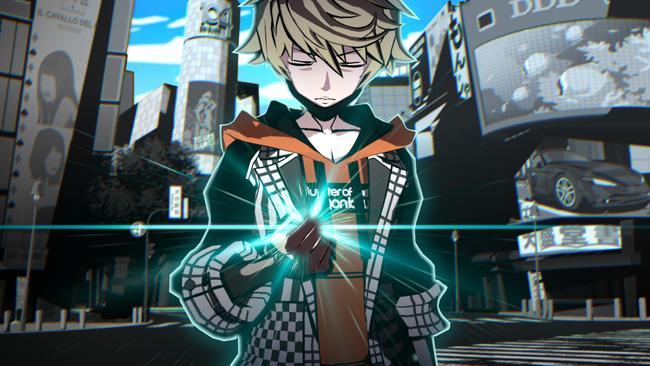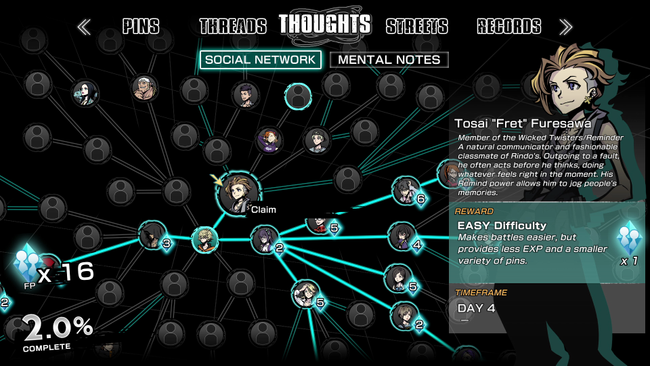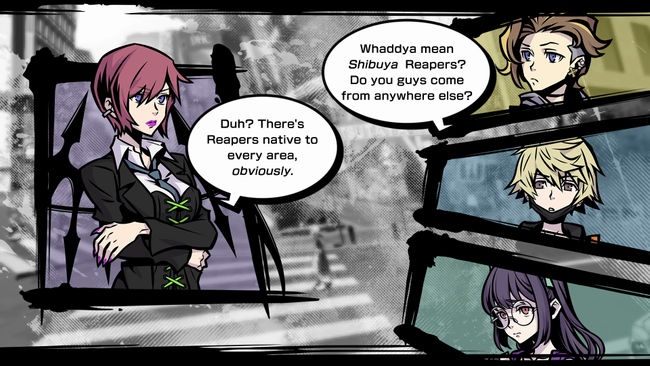NEO: The World Ends With You Review
Playing NEO: The World Ends With You was undoubtedly a very nostalgic experience. I didn’t play the original cult classic when it was first released on the DS (I was only 11 years old at the time), but I got around to it in my teenage years during a relatively formative period of my life. The main design philosophy around NEO seems to be taking what made that game so beloved but presenting it to a new generation of players. The visuals, music, and game design very apparently attempt to bring back a similar style.
It perhaps would have been safe to just make TWEWY again, only this time in 3D. In the first few hours of playing NEO, I even thought they did exactly that. However, after spending more and more time back in Shibuya, it’s clear that wasn’t the intent. What makes NEO so impressive is that it strives to be more than just a familiar retread.

I think NEO’s strength lays in how it balances referencing its lineage while innovating in new ways. It is absolutely overflowing with fanservice, and after all these years of wanting a follow-up, it feels earned. The core of the game, however, lies in the new characters and story, which aim to offer a wholly original experience. Rindo, the new protagonist, and his friends offer a fresh perspective into the Reaper’s game.
I’m incredibly limited in what I can actually discuss in terms of the game’s content, but that’s probably for the best. NEO falls in line with one of “those kinds of games” where almost anything that happens can be considered a spoiler. The storyline is certainly best taken in without any expectations; it’s a vital part of the game.
That doesn’t mean the narrative completely overshadows the gameplay though. There is plenty to see and do on the streets of Shibuya as you go about the daily missions to avoid erasure. One of my favorite things to do, however, was to simply take in the sights and indulge in the wonderful soundtrack. In this aspect, it felt comfortably “TWEWY”. The 2D drawn buildings that gave the original's adaptation of Shibuya such a unique texture have made an exceptionally effective transition into 3D. The buildings tower above you and move based on where you are. They quite literally warp around as you traverse, which might seem nauseating for some, but I found it to be beautiful.

The original TWEWY’s combat was uniquely obtuse in order to serve its themes, and it has plenty of defenders. I personally found the Solo and Final Remix simplified takes on the battle system to be enjoyable enough without taking too much away from the core idea. Even then, you would never find me saying that the battles were exceptionally fun. All versions of the original game were designed with a touch screen in mind, while NEO was designed to be played with controllers.
I mean this in the nicest possible way, especially since I’m a fan: NEO plays much more like an actual video game. You'll spend a lot of your time in this game fighting, but battles never grew old for me for a couple of key reasons.
The Pin-based system has been retained, but now each party member has their own individual pin, and each is tied to a button on the controller. Some pins are melee-based, some are magic-based, some shoot projectiles, and some can even use psychokinesis. There are several different kinds of pins you can collect & evolve as you play, and some of the tedium of the original system has been cut to streamline it. Now you no longer need to do strange things like put the system in sleep mode just to upgrade certain pins; all of them improve simply by using them in battles. The most complicated evolution gets is needing to level up one while having it equipped on a specific character, and that’s it.
Fighting Noise starts rather simple, but only becomes more intricate the longer you play. Every time you gain a new party member, and by extension a new active pin slot, the game feels like it completely changes for the better. You’re given all the tools needed to customize every aspect of your experience. Like in the original, you can lower your level to increase the drop rate of loot from a fight, and you can chain encounters to increase this further. Grinding is rarely required, but NEO makes it fun enough to fight enemies anyway, and it rewards you handsomely for engaging with it. The fights themselves are pure enjoyable chaos, plain and simple.

There's a lot going on at all times, and things only get crazier as you get more party members and stronger pins. This, unfortunately, leads to some performance problems, at least on the Nintendo Switch version. The framerate is demolished when things get too hectic, but despite that, I felt battle pace wasn’t significantly affected. I won’t spend a paragraph excusing it, but if a rock-solid 60 fps is more important than portability for you, then it'd probably be best to get the PS4 version.
Battles are less about precise movements and more about getting into the rhythm. Even with the chaotic 'anything goes' design, you can’t just spam abilities if you want to win. You have a gauge on the top called the Groove meter that will fill by timing your attacks so your characters work together. When your groove gauge is full, you can unleash a powerful attack.
The game wants you to learn how to play optimally, because the better you do, the better the rewards you get. You’re graded on your performance at the end of every battle, which will slowly help you see where you need to improve and encourage yourself to do so. Doing well in battles is one of the main ways to get new pins, which further allows you to personalize your team layout.
You gain new pins so often that your playstyle will naturally change frequently over the course of the game. For players who like RPGs to mix themselves up and avoid monotonous repetition, then NEO is for you. The best part about all of this is that the battle mechanics are designed to keep things fun, without losing sight of the themes of needing to work together with others.
I love the chaos when it comes to fighting normal noise encounters, but with so much freedom given to the player, balance was perhaps always going to be an issue. This is most significant with the boss battles. They start out harmless enough, but tend to get rather unfair on higher difficulties as you near the end of the game. Your party members often do a good job at keeping themselves safe and dodging attacks when you are not in direct control, but boss battle design can get rather annoying and a lot of unfair deaths begin to pop up.

Your entire group shares a health bar, but each party member has unique stats based on the clothing you equip on them and the food they eat. Their stats affect how good their pins are, and each character will naturally gravitate to a specific style of play. NEO is one of those games with a near-perfect feedback loop. Despite being somewhat rough around the edges, every mechanic feeds in and influences the others. You can’t really ignore one gameplay system without having the others be less effective. This has always been my favorite kind of game design, where all elements of a game synergize with each other, and I’m glad the attempt was made to refine and improve the original’s gameplay mechanics.
As I mentioned before, NEO works hard to differentiate itself from doing what the original title does. The biggest new gimmick is the time travel system, known as Replay. During certain days, the story will inevitably have Rindo and crew fail to achieve their goal. When that happens, he’ll have to use his special power to rewind the clock to precise moments and try to gather new information and manipulate time to his favor. I feel this could have been fleshed out better and less linearity in these moments would have gone a long way, but they mix up the gameplay and presentation of the story just enough to have it be a nonissue.
My favorite system in the entire game is the Social Network system. If there is one thing that perfectly connects the game's themes to the actual gameplay, it’s this. By helping others (mainly by doing side quests) you gain something called friendship points. By meeting new characters, going to new shops, and helping people, you’ll grow your social circles. This will be displayed in a menu, and each character has a node dedicated to them. You’ll learn a bit about themselves, but more importantly, there’s an ability locked behind a requirement and a certain amount of friendship points.

What the system really comes down to is unlocking small quality of life components by going out of your way to help others, and it’s the best version of the mechanic I’ve ever seen. Little things like automatically selling money pins or being able to bulk sell duplicate pins are some of the earliest unlocks, and I loved to see how much it rewarded me for wanting to see and do everything.
The dialogue and characters are what sell the whole package. NEO is about double the length of the original game, but because of how well-written the dialogue is, it never really feels like it. TWEWY’s pacing was breakneck - almost to its detriment. NEO gives its characters a lot more room to breathe, which slows the pacing down just a bit. There’s next to no filler, just more time with a wonderful cast of characters and a captivating story that I’m thrilled to see discussed in the future.
The themes of the two games have different goals, yet NEO doesn't wholly contrast with what its predecessor was trying to accomplish. Rindo is not Neku, and I’m sure he won’t resonate with everyone. He has a lot of room to grow at the start, and that growth is handled in a more subtle way than Neku’s. They exist as clever foils to one another, and I personally loved experiencing his journey. One of my favorite aspects of both of these games is how they are some of the only RPGs that feel made for teenagers without being condescending to them. Yes, adults can play and enjoy this game, but I think teenagers are sure to resonate with this game as much as I did with the original.

No review of a TWEWY game would be complete without discussing the musical score. Original composer Takeharu Ishimoto returns and I can easily say he outdid himself. There are roughly 30 new tracks along with about 20 remixes of old ones. All of it is outstanding and gives the game consistent energy. I enjoyed the Final Remix versions of the original DS game’s music, but none of that ever felt like it was truly that different. Every NEO mix breathes new life into old tracks, giving the game a distinct sound.
I could listen to the game’s music for hours, and I did - an immeasurable amount of hours, because NEO doesn’t actually list playtime. I’ll forgive them on this one though, because I’m sure if I did know how long I spent in my week playing the game nonstop I might've felt pathetic.
I think it's safe to say that NEO will not be for everyone. If what I described sounds up your alley, or you’re a fan of the original, then I’m sure the game will vibe with you hard. It’s been 14 years since The World Ends With You, and worries were aplenty when the sequel got announced. NEO delivered for me. I couldn’t put the game down, and I was captivated by this new time-traveling take on the Reaper’s game. I don’t know if we’ll ever get another shot at this universe, but after NEO I don’t think we need one. It’s not a perfect game, nor was the original, but it has a spirit and energy to it you just don’t see from other RPGs available.
NEO: The World Ends With You does a wonderful job recapturing what made this formula work so well on the DS, but in a more approachable way. If there’s one game in this duology I’ll ever find myself revisiting, it’ll definitely be this one. Few other games come close to conveying this kind of rebellious style in every aspect of its design, and NEO completely lived up to what I wanted from a TWEWY sequel.